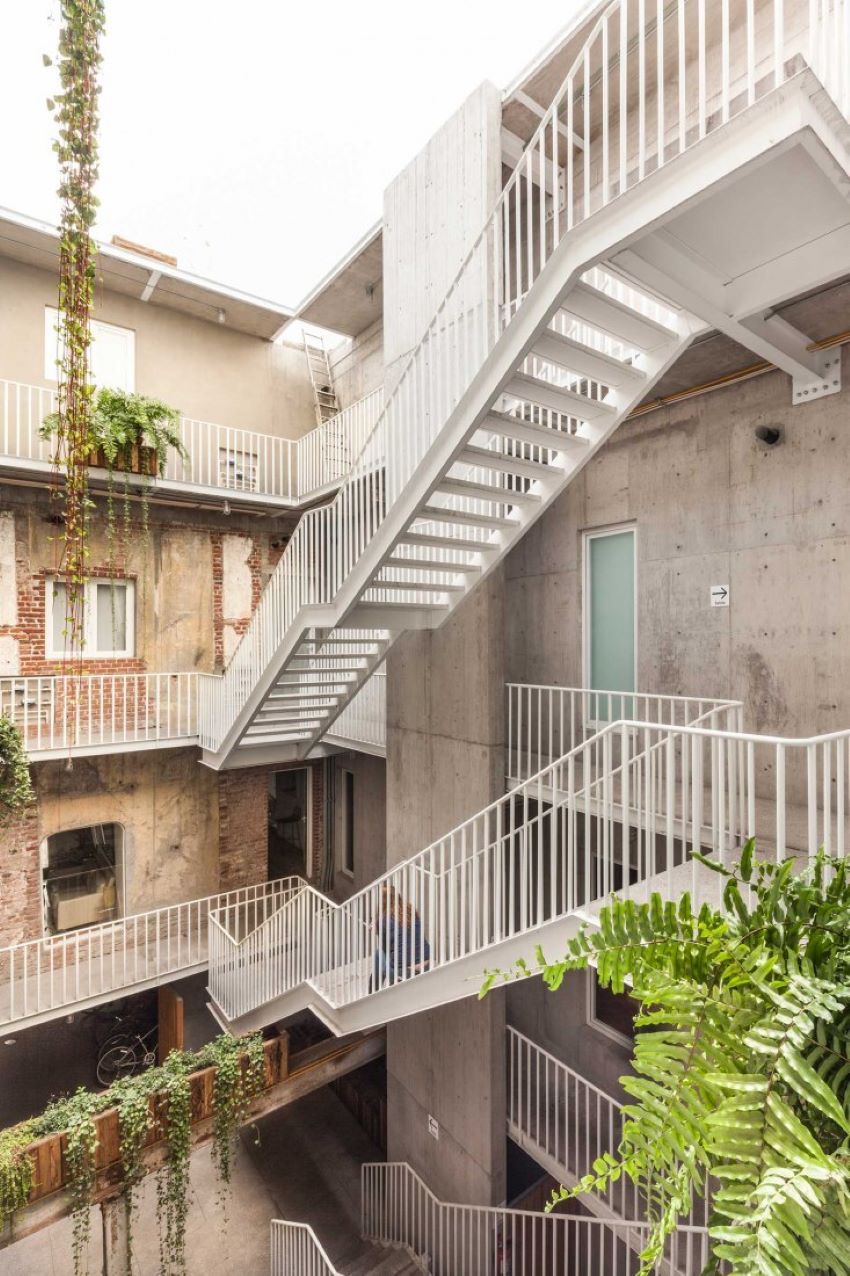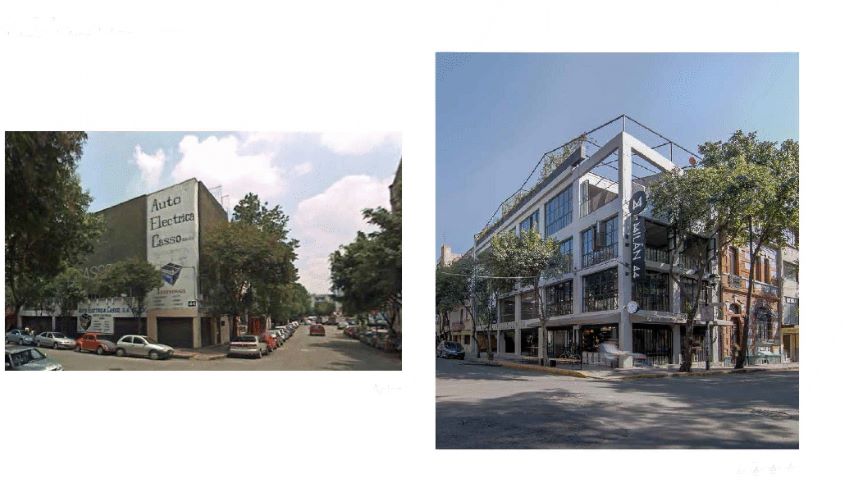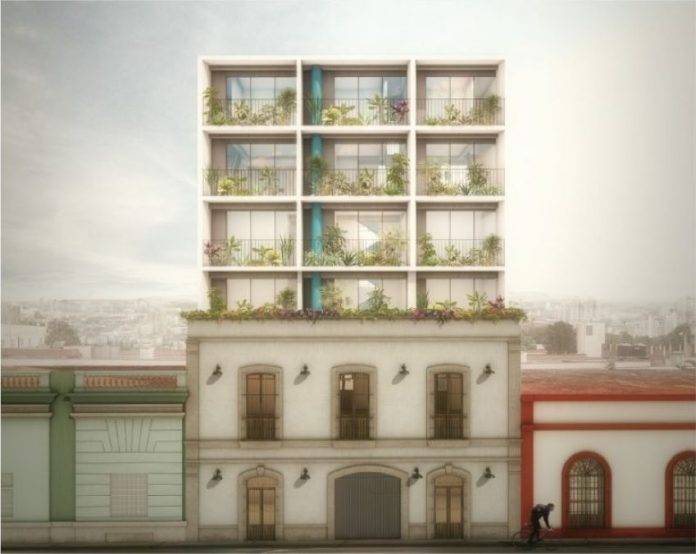It’s an interesting juxtaposition: new construction in an old, established neighborhood, keeping at least the old facade as — well — a facade.
It provokes mixed feelings. What is kept makes me wonder how much was lost.
This kind of development is done by various companies, and Reurbano specializes in it. One thing that distinguishes the firm, however, is that Reurbano conserves as much of the old building’s interior as possible. Company spokesman Andrés Sañudo says this ethos is almost “dogma” in the firm.
Reurbano’s partners are not conservationists in the classic sense of the word but rather dedicated to reciclaje urbano (urban recycling), applying the concept of recycling to old, neglected buildings. The result is new spaces which combine old and new.
“We work with respect for the blueprint of heritage to preserve and improve the historical character of the buildings,” Reurbano says on its website.

The firm began in 2010, when founders Rodrigo Rivero Borrelli and Alberto Kritzler began working together on two renovation projects just west of the capital’s historic center. Since then, the partnership has grown organically, adapting itself to the needs of the projects it takes on.
Its work is like that done in major cities all over the world, such as the conversion of old warehouses and other spaces into residences. However, Sañudo stresses that the sociodemographics of Mexico City present unique challenges and opportunities.
Most of Reurbano’s work is done in the neighborhoods that straddle Reforma and Insurgentes avenues, just west of the historic center proper. Neighborhoods such as Condesa, Juárez and Roma were built in the 19th and early 20th centuries for the wealthy. They had been experiencing decline as residents fled to new, car-friendly developments to the west, but severe damage from the 1985 earthquake hastened the process tremendously. Real estate prices plummeted, and structures became abandoned.
These neighborhoods have since experienced a comeback, primarily because they are so close to Mexico City’s financial center and other major employers. However, many abandoned and derelict structures remain in sections of these neighborhoods that haven’t bounced back so well.
Such buildings are attractive to certain niche markets because they’re located in neighborhoods with established personalities. These structures cannot be duplicated, and “they have a premium,” says Sañudo.
But the difficulties working with such properties are formidable. First, there are problems with crime and blight. Making the properties sellable or rentable means making the areas they are in more attractive. This can be as simple as planting trees and adding benches for passersby to increase foot traffic. Often it means working with local neighborhood associations to convince them that Reurbano’s interventions are for the common good.

One important long-term strategy Reurbano uses is to “cluster” projects on the same street or block so that the effect is cumulative, changing the face of that section of the neighborhood. Three of Reurbano’s early projects did just this, all located on Calle Havre, a small side street in Colonia Juárez.
When the street was all but a ghost town, the firm bought and reworked three old mansions there and even moved their offices to one of them. Since then, other developers have redeveloped five other structures on the same street.
The other strategy is to convert the buildings to mixed use. Upper floors have offices or residences, but the ground floor facing the street almost always has retail space. Reurbano does this to have the building “interact” with the neighborhood — to become part of it.
Redeveloping such buildings is complicated, time-consuming and expensive. There are more factors in the initial analysis, and there is always bureaucracy with heritage authorities. In addition, properties are on small lots, and most do not have garages or the ability to create one.
This means that Reurbano must market to a very different demographic than those who build suburban housing. Residences are targeted to professionals tired of long commutes and willing to shift their transport needs to public services, walking and biking. Such buyers are also attracted by the fact that many of these neighborhoods have small stores, restaurants and cultural centers close by.
Reurbano also has one other arrow in its quiver: often gentrification is preceded by the appearance of artists and other cultural entities who need cheap space — think SoHo, New York in the 1970s. To get this process going as soon as possible, Reurbano leases or rents spaces in its acquired buildings before renovations, sometimes free. The arrangement, Sañudo says, is win-win: the artists and cultural organizations get cheap space, and the area’s face begins to change long before any construction starts.
The firm has dipped its toes into a couple of areas outside its core zone — as far as Tacubaya in the west and Doctores and the historic center in the east. These areas are even more challenging as they are farther from employers and have stronger reputations for blight and crime. However, neither lacks for the “interesting spaces” that Reurbano seeks in potential projects.
The firm’s redevelopment process has been worked out over 10 years, with some problems along the way. Reurbano and other companies have been accused of gentrification practices that work against poor populations in the target neighborhoods. It received bad press a few years ago because of a building it acquired which had preexisting tenants. Mexican law and politics tend to favor occupants over owners. For this reason, they now stick only with truly abandoned buildings.
To date, Reurbano has 11 completed projects, three in progress and four others in planning. The firm has 35 employees, but it also outsources much of the work, meaning that a single project can employ up to 200 construction workers, architects, lawyers and others. Some of its projects have received recognition from architectural competitions and entities in Mexico and abroad.
Leigh Thelmadatter arrived in Mexico 17 years ago and fell in love with the land and the culture. She publishes a blog called Creative Hands of Mexico and her first book, Mexican Cartonería: Paper, Paste and Fiesta, was published last year. Her culture blog appears weekly on Mexico News Daily.
